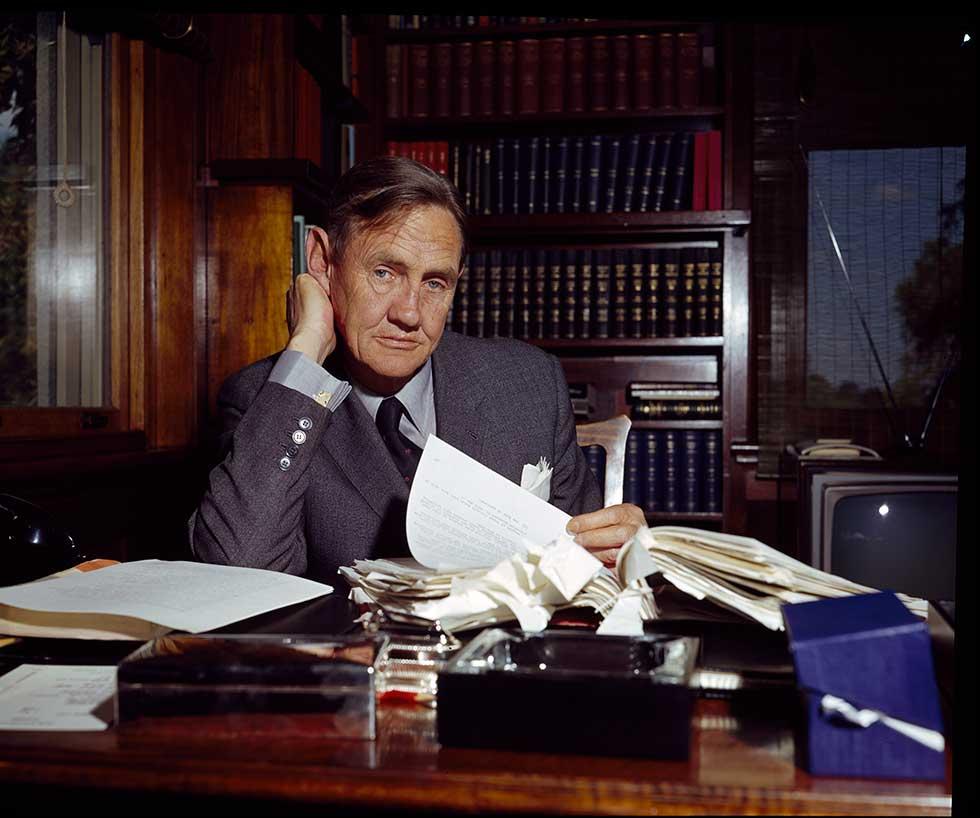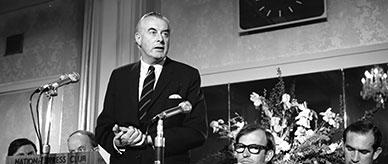


About this record
This is a colour photograph of Australian Prime Minister John Gorton at his desk in the prime minister's office in Old Parliament House, Canberra. Gorton is shown in an informal pose, one elbow on the desk, as if he had just looked up from reading through a file of papers. A cigarette box and ashtray sit on his desk in the foreground and wood-panelled walls, reference books and a television set can be seen in the background. The photograph was taken by the Australian News and Information Bureau.
Educational value
- This photograph shows the 19th Prime Minister of Australia, John Grey Gorton (1911–2002), in the first year of his term in office. He had come to the position in January 1968 in unusual circumstances after Liberal Prime Minister Harold Holt disappeared in December 1967. Gorton was not the expected successor to Holt's leadership of the Liberal Party, but had been elected after the Liberal's coalition partner had indicated it would not work with William McMahon (1908–88).
- Gorton was the only senator ever to become prime minister. By early 1968 he had served as a Liberal senator for Victoria for 18 years, having been first elected in December 1949. In order to function as prime minister, however, Gorton needed to be a member of the House of Representatives. In February 1968 he resigned from the Senate and won the by-election for Holt's safe Liberal seat of Higgins in the House of Representatives.
- At the time of the photograph Gorton was popular with the Australian public. His informal personal style, careless habits of dress and cigarette smoking combined with his distinctive personal appearance to project an image of something of a larrikin. During World War II Gorton served as a fighter pilot. He survived three plane crashes, with one causing severe facial injuries. Reconstructive surgery left him with a craggy look and lopsided grin.
- In 1968 Gorton was well accepted within the Liberal Party, but this was to change as he promoted social and economic policies that were often against the prevailing party views. He initiated progressive policies on free health care, increased social welfare, and funding for education and the arts, while his strengthening of Commonwealth powers over economic management made him unpopular with Liberal premiers and members of his own government.
- Gorton left the office of prime minister in an unusual way, just as he had gained it. In March 1971 a motion of confidence in his leadership was debated at a Liberal party room meeting. As chairman, Gorton gave his casting vote against the motion, effectively voting himself out of office as party leader and prime minister. Gorton continued to serve on the front and backbench until 1975, when he resigned from parliament.
- Commentators on his prime ministership speak of a 'Gorton style' of leadership, characterised by his relaxed and approachable manner, irreverence, a tendency to speak his views candidly and to make policy on the run, and a willingness to socialise outside his official duties. Such a personal style resonated with the mood of the time for social change but undoubtedly contributed to his political downfall.
Acknowledgments
Learning resource text © Education Services Australia Limited and the National Archives of Australia 2010.
Need help with your research?
Learn how to interpret primary sources, use our collection and more.

